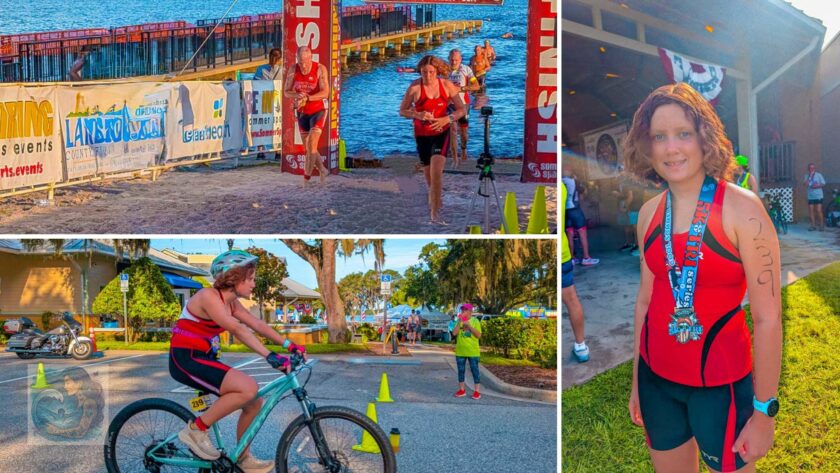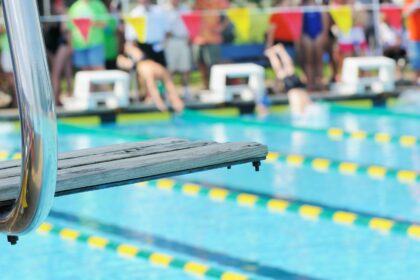I’ll never forget the nerves before my child’s first youth triathlon. It felt like we were entering a whole new world.
I remember staring at the event schedule, wondering if we’d survive the day. My child was excited, but I was overwhelmed. A youth triathlon sounds simple—swim, bike, run—but it’s anything but straightforward for beginners. Parents often feel lost about what gear is essential, what distances are appropriate, and even how does triathlon work for kids.
Youth Triathlon Tips: What I Wish I Knew Before My Kid’s First Race
I wish someone had handed me a clear, no-nonsense guide back then. I learned the hard way that you don’t need to spend a fortune on gear. A basic youth triathlon suit, a well-fitted helmet, and the right shoes are often enough. With the right beginner triathlon gear and mindset, your child can enjoy the race without added stress.
This post is for parents just starting out. I’ll share kids triathlon tips, explain what to expect at a sprint triathlon for kids, and help you navigate training. Together, we’ll dive into the must-know basics so both you and your athlete can cross that finish line smiling.
What is a Youth Triathlon (and How Does It Work)?
A youth triathlon is a scaled-down version of the adult race. It includes swimming, biking, and running with shorter, age-appropriate distances. Events are designed to be safe and fun, focusing on participation and confidence rather than strict competition.
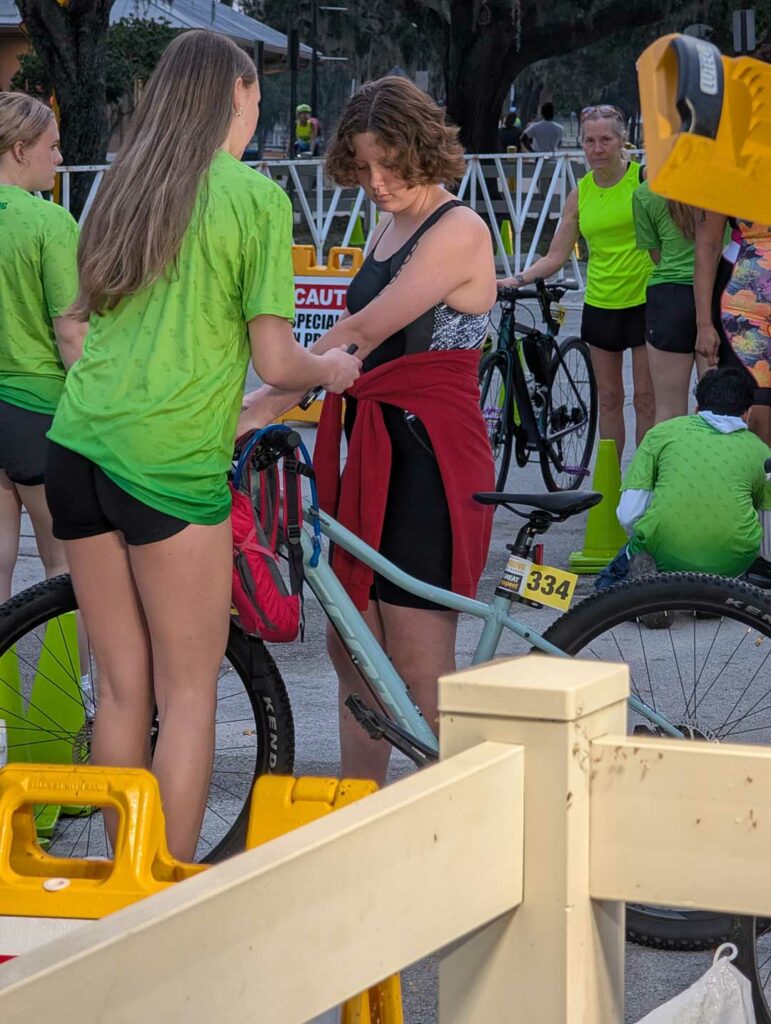
Most races follow a triathlon for beginners format. Younger kids might swim 50–100 yards, bike 1–3 miles, and run less than a mile. Older athletes face slightly longer distances, similar to a sprint triathlon for kids, but still manageable for youth athletes.
Wondering how does triathlon work for your child? The structure is simple but varies by event. Kids start with the swim, then transition to the bike, and finish with the run. Each transition area is clearly marked, but parents should walk their child through the setup beforehand.
Local events are often run by community organizations or triathlon clubs. Look for youth-focused races or pool-based events, which are perfect for beginners. These smaller events let kids practice without the intimidation of open-water swims.
If your child is already a swimmer, they’re a step ahead. Swimming skills give them confidence during the first leg of the race, which is often the hardest part for beginners.
Youth Triathlons vs. Sprint Triathlons for Kids
Not all kids start with a standard youth triathlon. My daughter jumped into sprint triathlons instead, which include both adults and kids. These races have longer distances, but they’re still beginner-friendly. For example, her last race was a 450-meter swim, 8-mile bike, and 5K run.
These events are exciting because kids compete alongside adults, yet awards are separated by age group. I’ve learned that with the right training and support, sprint races can be a confidence boost for kids who already have experience with swimming or running.
Essential Kids Triathlon Tips Every Parent Should Know
Preparing for a youth triathlon can feel like juggling three sports at once—because it is! The good news? Kids don’t need a complicated plan to succeed.
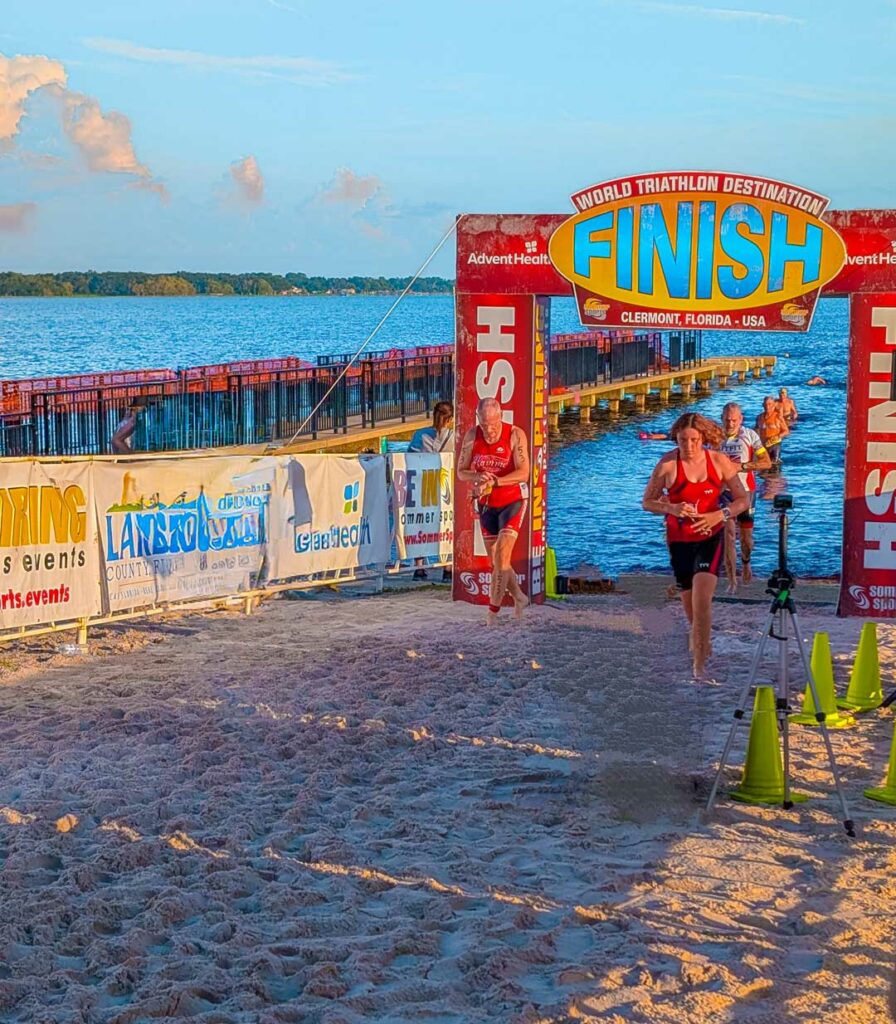
What they need most is support, encouragement, and a few smart strategies. These kids triathlon tips will help your child train safely, stay motivated, and enjoy every step of the journey.
Start Small with Training
Keep training simple and fun. A youth triathlon should feel exciting, not overwhelming. Start with short workouts for each sport—maybe a quick swim, a short bike ride, or an easy run. Mix in play, like racing each other in the pool or biking to a favorite spot.
Balance is key. Rotate swimming, biking, and running throughout the week to avoid burnout. Kids don’t need heavy schedules to succeed. Consistent, low-pressure training builds endurance and confidence over time.
Safety First
Safety always comes first. Make sure your child knows the rules and understands race etiquette. A helmet, reflective clothing, and proper bike checks are non-negotiable.
Teach them about pacing and rest days to prevent injuries. Encourage water breaks during training and pre-race hydration. Remind them that listening to their body is just as important as pushing through tough moments.
Mindset Matters
A healthy mindset can make or break race day. Remind your child that a youth triathlon is about effort, not just winning.
Celebrate small milestones like mastering transitions or finishing strong.
First-timers often get nervous, and that’s okay. Talk through the race steps, visit the transition area early, and cheer for every accomplishment.
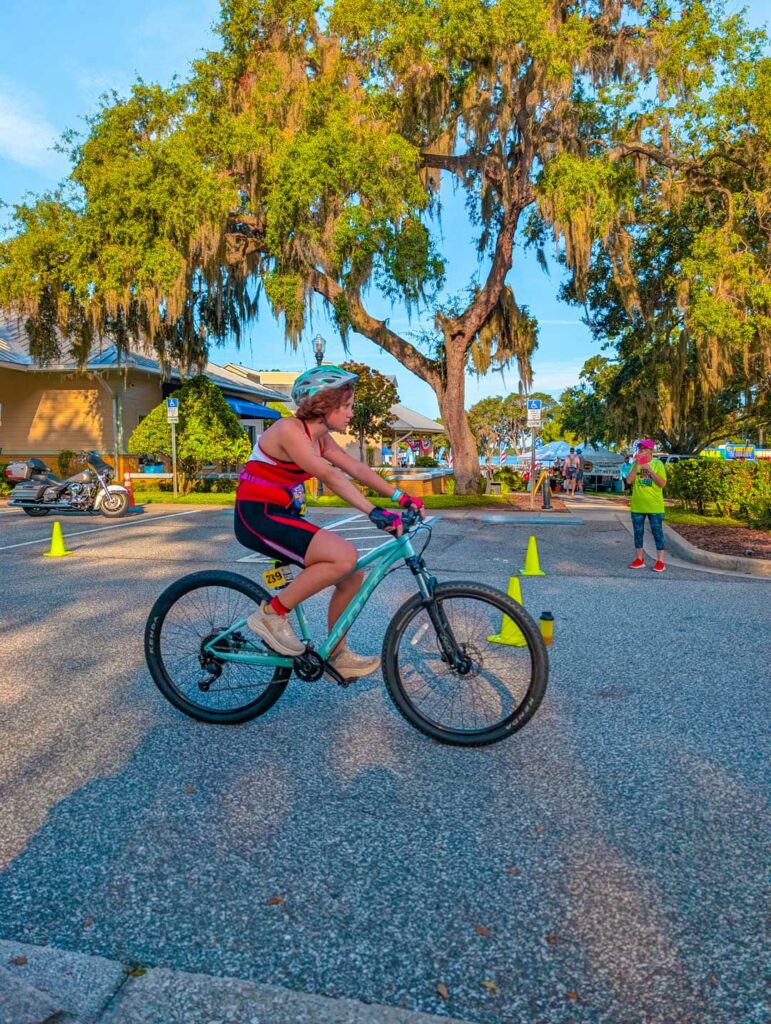
Confidence grows when kids know they are supported no matter their placement.
Beginner Triathlon Gear You Actually Need
When starting a youth triathlon, you don’t have to buy every flashy item you see online. Use what your child already has. For example, a basic bike, a pair of well-fitting running shoes, and comfortable swim goggles are often enough for that first race.
Choosing the Right Youth Triathlon Suit
A youth triathlon suit should be quick-drying, comfortable, and easy to move in during transitions. Look for a snug fit, flexible fabric, and an easy-to-use zipper.
From experience, I can say that a two-piece suit often works better for kids than a one-piece. My daughter prefers the TYR triathlon shorts and tank, and they’ve been her personal favorite.
We’ve tried a lot of suits over the years, and these were worth the investment. They’re high quality, quick-dry, and comfortable enough that she doesn’t need to change anything during transitions.
If you’re on a tighter budget, padded bike shorts with a quick-dry top can work as an alternative. Just don’t skip the padding—no child wants to bike several miles in discomfort! You can link to beginner-friendly suits or bike shorts here.
Essential Gear Checklist
- Helmet: A well-fitted bike helmet is non-negotiable. Link to a safe, affordable option for kids.
- Bike: Any safe, well-maintained bike works for a sprint triathlon for kids. A lightweight model can make a difference, but it’s not necessary.
- Running Shoes: Lightweight, supportive shoes with good traction are best.
- Tri-Suit or Bike Shorts: Padded shorts or a tri-suit prevent discomfort on the bike and make transitions easier.
- Swim Goggles: Comfort matters more than brand here. Link to reliable, kid-friendly goggles.
- Swim Cap: Most races provide a basic cap, but we prefer a silicone cap for better fit. My daughter even double caps for extra security.
- Race Belt: A simple race belt makes transitions faster and avoids the hassle of safety pins.
Pro Tip: Keep It Affordable
Buying second-hand gear or borrowing items is smart for beginners. Kids grow fast, and their needs may change as they explore the sport. Upgrade gradually as they become more serious about triathlon, especially for beginners or longer events.
My Mistakes and What I’d Do Differently
I’ve made plenty of mistakes on this journey, and I want to save you from the same stress. My biggest lesson? Get there early—way earlier than you think you need to. We were once cutting it close, not late for the race start, but almost too late to grab her bib, timing chip, and set up her transition area. Add in bike inspections, and we were in a mad rush. Now, I aim to arrive with plenty of time to breathe, prepare, and calm those pre-race jitters.
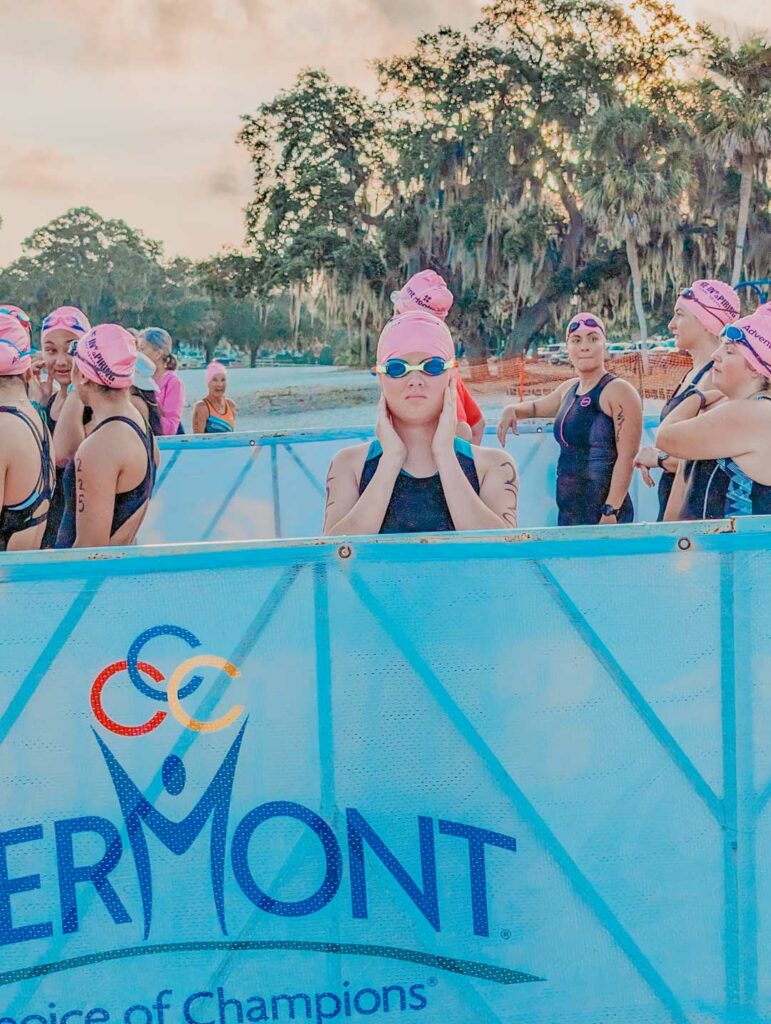
When we first started, we didn’t invest in a youth triathlon suit right away. Instead, my daughter swam in a regular swimsuit and then pulled padded bike shorts over it in transition.
It worked, but it slowed her down and added unnecessary stress. Switching to a two-piece tri suit (we love TYR) made transitions faster and much smoother.
We also learned the hard way about race belts. Triathletes need their paper bib for both the bike and run segments, but obviously not for the swim. Trying to pin on a bib in transition is a nightmare under pressure. A simple race belt lets you slip the number on in seconds, saving time and frustration.
If I could go back, I’d focus less on buying “all the gear” and more on learning what makes the race day experience smoother and less stressful for both of us. Flexibility and preparation make all the difference.
Race Day Tips for Parents and Kids
Race day can feel chaotic if you’re not prepared. A little planning goes a long way toward making the event fun and stress-free. These tips will help both you and your child feel confident and ready.
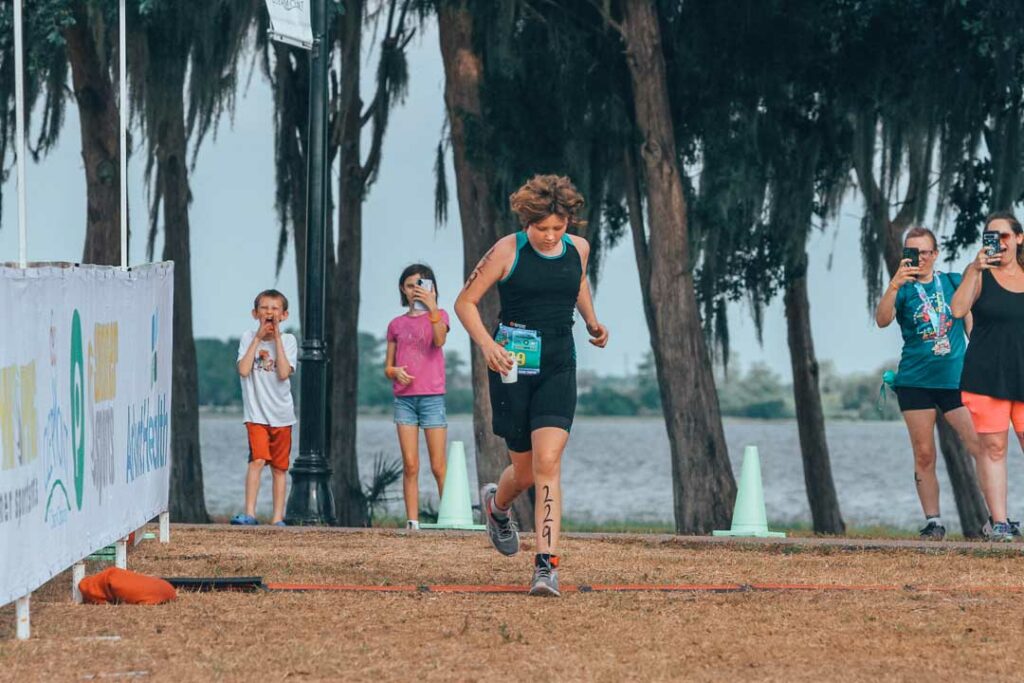
Pack Smart and Arrive Early
The night before, pack everything your child might need. Bring snacks, plenty of water, extra goggles, and at least two towels. If they use a favorite swim cap or gear like a race belt, double-check that it’s packed.
Arrive early—much earlier than you think necessary. You need time to grab the bib, pick up the timing chip, set up the transition area, and get the bike inspected. Being early gives your child a chance to settle nerves instead of rushing to the start.
Keep It Positive
Your energy sets the tone. Avoid being the “overbearing” parent on race day. Kids perform better when they feel supported, not pressured.
Celebrate every victory, no matter how small. Finishing strong, shaving seconds off a transition, or simply having the courage to start the race are all wins worth cheering for.
Final Thoughts on Triathlon for Beginners
Watching your child train for and complete a youth triathlon is an experience filled with pride and excitement. Remember, the journey is about more than crossing the finish line. It’s about building confidence, developing healthy habits, and having fun along the way.
Keep the focus on your child’s personal growth rather than competition. Celebrate small victories—like smoother transitions or simply finishing the race with a smile. As parents, our role is to encourage, cheer, and make the experience memorable for the right reasons.
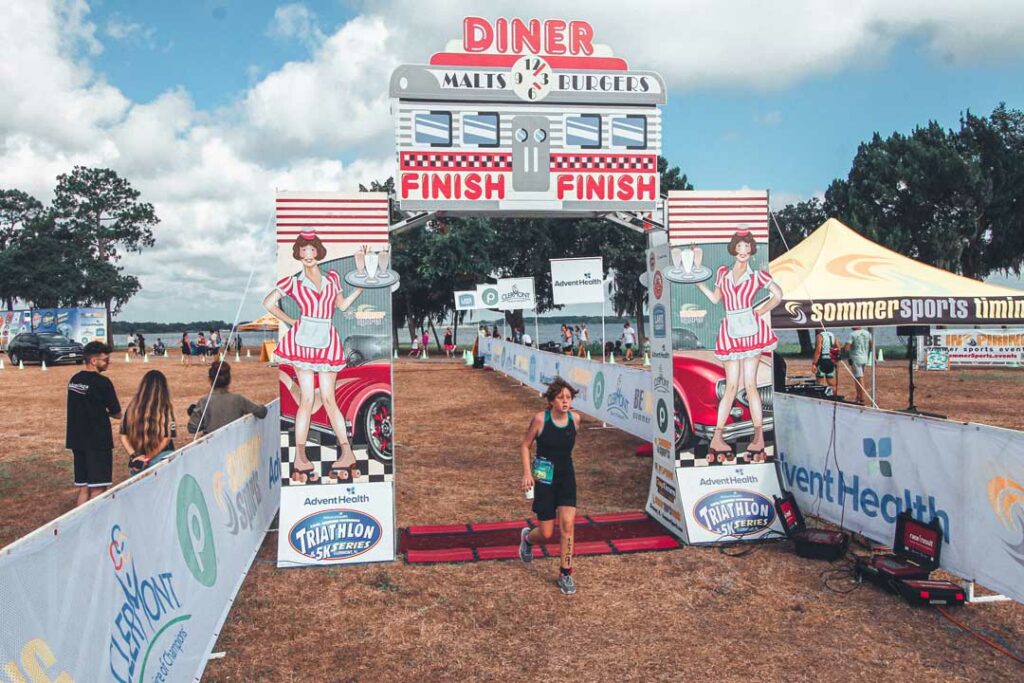
What’s your #1 tip for a youth triathlon? Share in the comments!
FAQs About Youth Triathlons
Most youth triathlons are designed for kids ages 6–17, with age groups divided for fair competition.
Basic gear includes a youth triathlon suit or padded bike shorts, a helmet, running shoes, swim goggles, and a towel.
A tri suit is helpful but not mandatory. Regular sportswear works if it’s quick-drying and comfortable, though transitions may be slower.
A sprint triathlon for kids usually involves shorter distances—like a 100–400 meter swim, 3–10 mile bike, and 1–3 mile run.
Triathlons follow a swim-bike-run format. Kids transition between events using a designated area, with timing chips tracking their overall performance.

